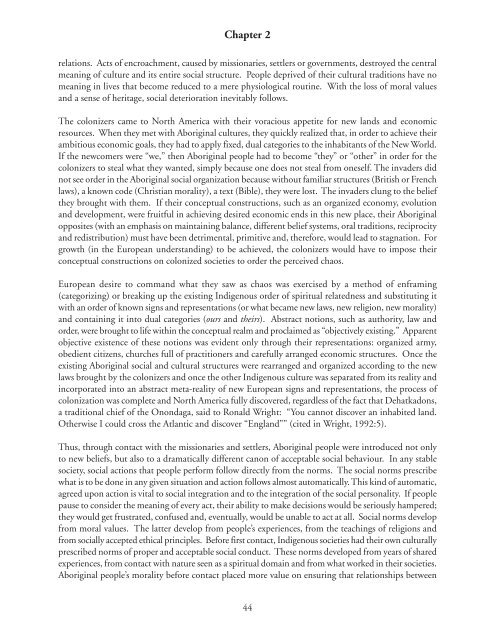Historic Trauma and Aboriginal Healing
by Cynthia C. Wesley-Esquimaux, Ph.D. and Magdalena Smolewski, Ph.D.
by Cynthia C. Wesley-Esquimaux, Ph.D. and Magdalena Smolewski, Ph.D.
You also want an ePaper? Increase the reach of your titles
YUMPU automatically turns print PDFs into web optimized ePapers that Google loves.
Chapter 2<br />
relations. Acts of encroachment, caused by missionaries, settlers or governments, destroyed the central<br />
meaning of culture <strong>and</strong> its entire social structure. People deprived of their cultural traditions have no<br />
meaning in lives that become reduced to a mere physiological routine. With the loss of moral values<br />
<strong>and</strong> a sense of heritage, social deterioration inevitably follows.<br />
The colonizers came to North America with their voracious appetite for new l<strong>and</strong>s <strong>and</strong> economic<br />
resources. When they met with <strong>Aboriginal</strong> cultures, they quickly realized that, in order to achieve their<br />
ambitious economic goals, they had to apply fixed, dual categories to the inhabitants of the New World.<br />
If the newcomers were “we,” then <strong>Aboriginal</strong> people had to become “they” or “other” in order for the<br />
colonizers to steal what they wanted, simply because one does not steal from oneself. The invaders did<br />
not see order in the <strong>Aboriginal</strong> social organization because without familiar structures (British or French<br />
laws), a known code (Christian morality), a text (Bible), they were lost. The invaders clung to the belief<br />
they brought with them. If their conceptual constructions, such as an organized economy, evolution<br />
<strong>and</strong> development, were fruitful in achieving desired economic ends in this new place, their <strong>Aboriginal</strong><br />
opposites (with an emphasis on maintaining balance, different belief systems, oral traditions, reciprocity<br />
<strong>and</strong> redistribution) must have been detrimental, primitive <strong>and</strong>, therefore, would lead to stagnation. For<br />
growth (in the European underst<strong>and</strong>ing) to be achieved, the colonizers would have to impose their<br />
conceptual constructions on colonized societies to order the perceived chaos.<br />
European desire to comm<strong>and</strong> what they saw as chaos was exercised by a method of enframing<br />
(categorizing) or breaking up the existing Indigenous order of spiritual relatedness <strong>and</strong> substituting it<br />
with an order of known signs <strong>and</strong> representations (or what became new laws, new religion, new morality)<br />
<strong>and</strong> containing it into dual categories (ours <strong>and</strong> theirs). Abstract notions, such as authority, law <strong>and</strong><br />
order, were brought to life within the conceptual realm <strong>and</strong> proclaimed as “objectively existing.” Apparent<br />
objective existence of these notions was evident only through their representations: organized army,<br />
obedient citizens, churches full of practitioners <strong>and</strong> carefully arranged economic structures. Once the<br />
existing <strong>Aboriginal</strong> social <strong>and</strong> cultural structures were rearranged <strong>and</strong> organized according to the new<br />
laws brought by the colonizers <strong>and</strong> once the other Indigenous culture was separated from its reality <strong>and</strong><br />
incorporated into an abstract meta-reality of new European signs <strong>and</strong> representations, the process of<br />
colonization was complete <strong>and</strong> North America fully discovered, regardless of the fact that Dehatkadons,<br />
a traditional chief of the Onondaga, said to Ronald Wright: “You cannot discover an inhabited l<strong>and</strong>.<br />
Otherwise I could cross the Atlantic <strong>and</strong> discover “Engl<strong>and</strong>”” (cited in Wright, 1992:5).<br />
Thus, through contact with the missionaries <strong>and</strong> settlers, <strong>Aboriginal</strong> people were introduced not only<br />
to new beliefs, but also to a dramatically different canon of acceptable social behaviour. In any stable<br />
society, social actions that people perform follow directly from the norms. The social norms prescribe<br />
what is to be done in any given situation <strong>and</strong> action follows almost automatically. This kind of automatic,<br />
agreed upon action is vital to social integration <strong>and</strong> to the integration of the social personality. If people<br />
pause to consider the meaning of every act, their ability to make decisions would be seriously hampered;<br />
they would get frustrated, confused <strong>and</strong>, eventually, would be unable to act at all. Social norms develop<br />
from moral values. The latter develop from people’s experiences, from the teachings of religions <strong>and</strong><br />
from socially accepted ethical principles. Before first contact, Indigenous societies had their own culturally<br />
prescribed norms of proper <strong>and</strong> acceptable social conduct. These norms developed from years of shared<br />
experiences, from contact with nature seen as a spiritual domain <strong>and</strong> from what worked in their societies.<br />
<strong>Aboriginal</strong> people’s morality before contact placed more value on ensuring that relationships between<br />
44


















